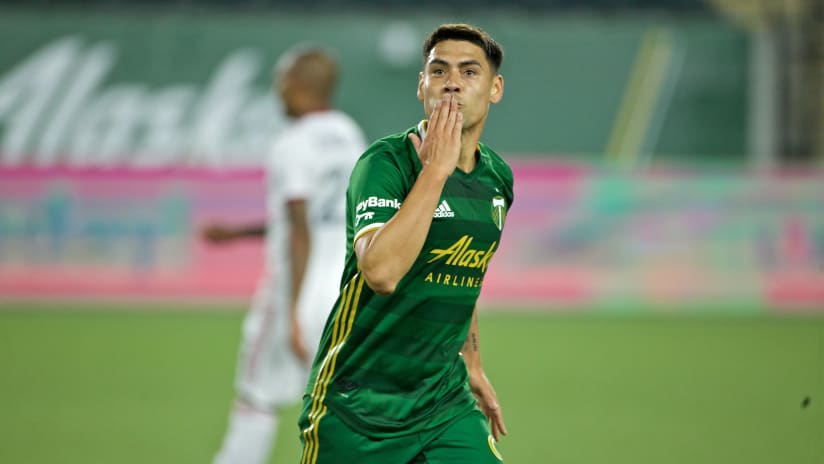Felipe Mora was the Portland Timbers’ starter at forward for the team’s first two games of the 2020 Major League Soccer season, but after an injury suffered before the MLS is Back Tournament, he’s found himself lower on the team’s depth chart. Though he worked his way back into playing time by MLS is Back’s end, fellow forward Jeremy Ebobisse had a team of the tournament-caliber performance in Orlando, while another striker, Jaroslaw Niezgoda, began seeing his first major minutes as a Timber.
On Saturday, Mora took another step toward reclaiming some of the playing time he has lost. Scoring what felt like a game-sealing goal in the 85h minute against Real Salt Lake, Mora recorded his first Timbers goal, giving his team a 4-2 lead in a match they would go on to draw, 4-4.
“I am very happy about my first goal,” the Chilean forward said on Monday. “For a long time, I’ve been waiting for [the goal]. And of course, I’m very happy that it’s my first goal in a Timbers shirt. Hopefully, I can continue the trend.”
In early March, Ebobisse was still working back from an offseason knee injury, while Niezgoda was building back from his own injury concerns. Mora, having arrived on loan from Mexican club Cruz Azul at the end of January, quickly found himself at the top of the Timbers’ forward depth chart. He drew a penalty in the team’s season opening game against Minnesota United FC, which captain Diego Valeri converted for Portland’s first competitive goal of the year.
Since his return from injury, Mora’s been asked to go beyond his striker’s role. As a substitute, he’s spent time on the right side of Portland’s attack, frequently coming into matches that have already featured Ebobisse, Niezgoda, or both.
Saturday’s game highlighted what Mora can do from his natural position. On the counterattack, he was able to stand up RSL’s Nedum Onuoha just inside the penalty area, using the defender as a shield before finishing inside goalkeeper Andrew Putna’s right post.
“I thought Mora was very good after he came on ...,” Portland head coach Giovanni Savarese said. “I saw he had an idea of what the team needed when he entered the game. He scored a great goal, created other opportunities. He’s important for us. He has a lot of talent.”
That talent has made the Timbers’ forward options a persistent point of curiosity throughout the season. Implied in some of the questions posed of Savarese: How can Portland get more than one striker on the field at the same time?
Both Ebobisse and Mora have shown they can provide minutes on the wing, but for a team that has played a 4-2-3-1 formation most of the season, Portland may need to use another shape to fully leverage their striking talents.
“Whoever is in the starting lineup or in the team,” Savarese explained on Monday, “when it’s Niezgoda and Mora, Jeremy and Mora, or Jeremy and Niezgoda, any [of the combinations] are possible.”
In preseason, even before Ebobisse and Niezgoda were fully healthy, Portland began working with a 4-3-1-2 formation, using a diamond midfield to support a two-striker approach. In theory, the shape could get at least two of the team’s three forwards into a starting lineup. Although the team did the same on Saturday against RSL – when Ebobisse started on the right of the Timbers’ standard 4-2-3-1 look – the preseason look allowed the Timbers to give a second striker more minutes at their natural position.
When talking about the potential for increased minutes for Mora, Savarese said his recovery before Wednesday night’s game against the LA Galaxy (7:30pm PT, FOX 12 PLUS (KPDX)) would influence the decision, as would the work he puts in during practice. ”Like I always say,” he reminded, his team feels the forwards can play together, even if they’re in competition.
As for Mora’s perspective on that competition, the Chilean spoke positively about the relationships he has with Ebobisse and Niezgoda, calling each “competitive and respectful.”
“For instance, this week with ‘Jebo,’” Mora said, referring to Ebobisse by his nickname, “we have been able to talk a lot and help each other, not only during the games but also during practices. We especially talk a lot about finishing, often staying after everybody is gone [from practice] to work on it.
“That’s something that really gives me a sense of competition. It’s something I appreciate. On the whole, [the strikers’] relationship is very good.”












